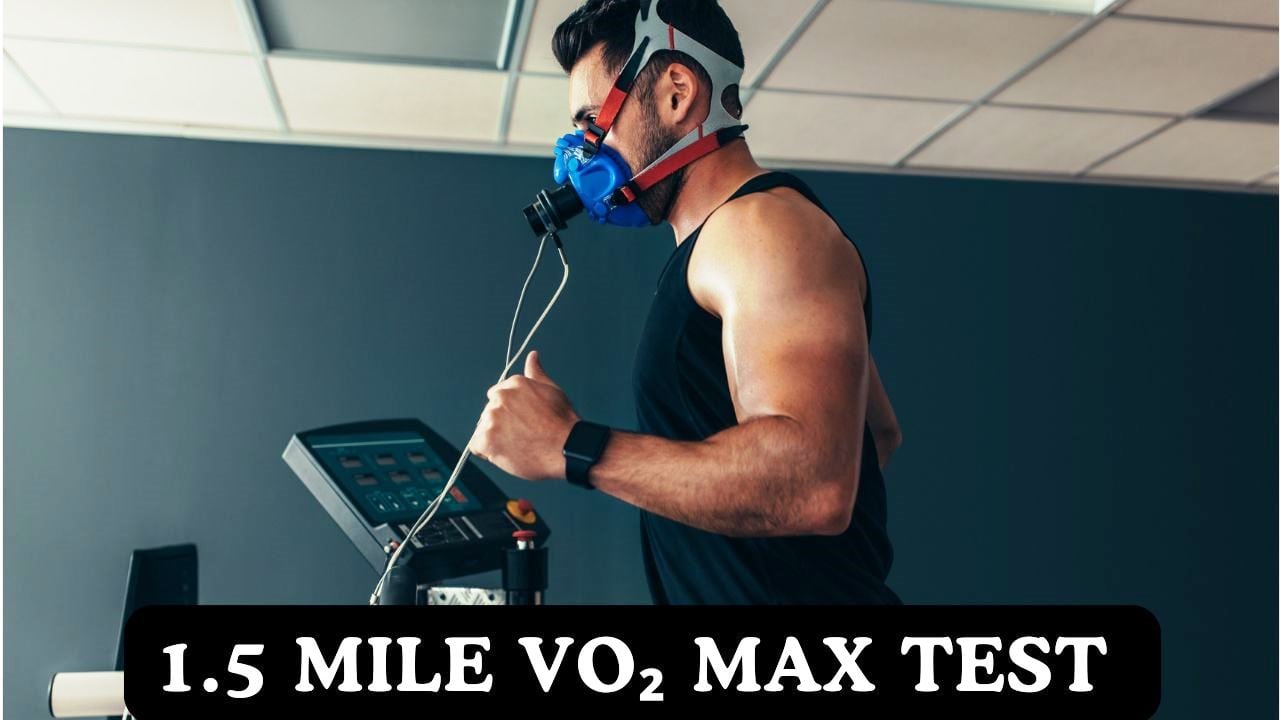🏃♂️ 1.5 Mile VO₂ Max Test Calculator
Calculate your cardiovascular fitness using the scientifically validated 1.5-mile run test with gender-specific regression equations

1.5 Mile Run VO₂ Max Test
The 1.5-mile run test is a scientifically validated field test for predicting VO₂ max using gender-specific regression equations. Research by McNaughton et al. (1998) demonstrates strong correlation (r=0.87) between 1.5-mile run performance and actual VO₂ max measurements, making it one of the most accurate field tests available.
Scientific Formulas
Gender-specific regression equations provide accurate VO₂ max predictions.
Male: VO₂max = 108.844 – (0.1636 × Weight_kg) – (1.438 × Time_min) – (0.1928 × Age)
Female: VO₂max = 100.434 – (0.1636 × Weight_kg) – (1.438 × Time_min) – (0.1928 × Age)
Validated research confirms these equations’ accuracy.
Test Protocol
Complete 1.5 miles (2.4 km) as quickly as possible on a flat, measured course. Proper warm-up and pacing strategy are essential for accurate results. The test requires maximal effort and should only be performed by individuals cleared for vigorous exercise.
Accuracy & Validity
Studies show 85-90% correlation with laboratory VO₂ max testing. Comparative research demonstrates the 1.5-mile run as the most accurate field test, superior to Cooper 12-minute run and shuttle tests.
Regression Equation Details
Male Formula
VO₂max = 108.844 - (0.1636 × BW_kg) - (1.438 × T_min) - (0.1928 × Age)
Variables:
- BW_kg = Body weight in kilograms
- T_min = Run time in minutes (decimal)
- Age = Age in years
Female Formula
VO₂max = 100.434 - (0.1636 × BW_kg) - (1.438 × T_min) - (0.1928 × Age)
Key Differences:
- Lower baseline constant (100.434 vs 108.844)
- Same weight, time, and age coefficients
- Accounts for physiological differences
Calculation Example
Subject: 30-year-old male, 75 kg, 12:30 run time
Calculation:
VO₂max = 108.844 – (0.1636 × 75) – (1.438 × 12.5) – (0.1928 × 30)
VO₂max = 108.844 – 12.27 – 17.975 – 5.784
Result: VO₂max = 72.8 ml/kg/min
VO₂ Max Fitness Standards
| Age Group | Gender | Poor | Fair | Average | Good | Excellent |
|---|---|---|---|---|---|---|
| 20-29 | Male | <25 | 25-33 | 34-42 | 43-52 | >52 |
| Female | <23 | 23-28 | 29-34 | 35-44 | >44 | |
| 30-39 | Male | <23 | 23-30 | 31-39 | 40-48 | >48 |
| Female | <20 | 20-25 | 26-31 | 32-40 | >40 | |
| 40-49 | Male | <20 | 20-27 | 28-35 | 36-44 | >44 |
| Female | <17 | 17-22 | 23-28 | 29-36 | >36 | |
| 50-59 | Male | <18 | 18-24 | 25-32 | 33-40 | >40 |
| Female | <15 | 15-20 | 21-25 | 26-32 | >32 | |
| 60+ | Male | <16 | 16-22 | 23-28 | 29-36 | >36 |
| Female | <13 | 13-17 | 18-23 | 24-30 | >30 |
Test Administration Protocol
Pre-Test Preparation
- Medical Clearance: Ensure participant is cleared for vigorous exercise
- Course Setup: Flat, measured 1.5-mile (2.4 km) track or route
- Weather: Avoid extreme temperatures (ideal: 50-70°F, low humidity)
- Timing: Avoid testing within 3 hours of eating
- Equipment: Accurate stopwatch, measured course, comfortable running shoes
Warm-up Protocol
- 5-10 minutes: Light jogging or brisk walking
- Dynamic stretching: Leg swings, high knees, butt kicks
- Pace familiarization: 2-3 short accelerations
- Rest period: 2-3 minutes before test start
- Hydration: Small sips of water as needed
Test Execution
- Pacing strategy: Aim for negative split (faster second half)
- Effort level: 85-95% maximum perceived exertion
- Monitoring: Record split times at 0.5-mile intervals
- Safety: Have medical personnel available for high-risk participants
- Motivation: Provide encouragement and time updates
Post-Test Recovery
- Cool-down: 5-10 minutes walking
- Stretching: Static stretches for major muscle groups
- Hydration: Replace fluids lost during test
- Monitoring: Check for signs of overexertion
- Documentation: Record exact time, environmental conditions
Field Test Comparison
| Test Type | Duration | Correlation with VO₂ Max | Advantages | Limitations |
|---|---|---|---|---|
| 1.5 Mile Run | 6-25 minutes | r = 0.87 | High accuracy, standardized | Requires maximal effort |
| Cooper 12-min Run | 12 minutes | r = 0.87 | Fixed time duration | Pacing challenges |
| 20m Shuttle Run | 5-15 minutes | r = 0.82 | Progressive intensity | Lower correlation |
| Submaximal Cycle | 6-12 minutes | r = 0.85 | Safer for at-risk populations | Requires equipment |
Research Applications & Limitations
The 1.5-mile run test has extensive validation in research and practical applications. McNaughton et al. research confirms its superiority over other field tests:
- Military Fitness: Standard test for armed forces worldwide due to practical relevance and accuracy.
- Athletic Screening: Baseline assessment for endurance sports and team sport conditioning.
- Clinical Research: Population fitness studies and intervention effectiveness measurement.
- Occupational Health: Fitness requirements for physically demanding jobs (firefighters, police).
- Exercise Prescription: Establishing training zones and monitoring fitness improvements.
- Health Promotion: Community fitness assessments and health screening programs.
Test Limitations & Considerations:
- Maximal Effort Required: May not be suitable for sedentary or high-risk individuals
- Running Skill Dependency: Performance affected by running economy and biomechanics
- Environmental Sensitivity: Weather conditions significantly impact results
- Motivation Dependent: Requires high motivation and pain tolerance for accurate results
- Body Weight Influence: Formula accounts for weight but may underestimate fit, heavy individuals
- Age Range: Most validated for adults 18-65 years old
📊 Results Interpretation & Training Applications
🏆 Excellent (>80th percentile)
Characteristics: Superior cardiovascular fitness, competitive athlete level
Training Focus: Maintain fitness, sport-specific training, high-intensity intervals
Health Outlook: Minimal cardiovascular disease risk, excellent metabolic health
✅ Good (60th-80th percentile)
Characteristics: Above average fitness, recreational athlete level
Training Focus: Progressive overload, variety in training modalities
Health Outlook: Low cardiovascular disease risk, good metabolic health
⚖️ Average (40th-60th percentile)
Characteristics: Typical fitness for age group, meets basic health recommendations
Training Focus: Increase exercise frequency and duration gradually
Health Outlook: Moderate cardiovascular disease risk, room for improvement
⚠️ Fair/Poor (<40th percentile)
Characteristics: Below average fitness, sedentary lifestyle indicators
Training Focus: Begin structured exercise program with medical clearance
Health Outlook: Elevated cardiovascular disease risk, significant improvement potential
References

Manish is a NASM-certified fitness and nutrition coach with over 10 years of experience in weight lifting and fat loss fitness coaching. He specializes in gym-based training and has a lot of knowledge about exercise, lifting technique, biomechanics, and more.
Through “Fit Life Regime,” he generously shares the insights he’s gained over a decade in the field. His goal is to equip others with the knowledge to start their own fitness journey.
